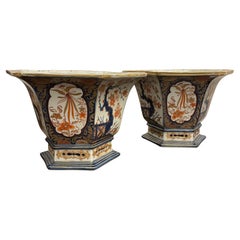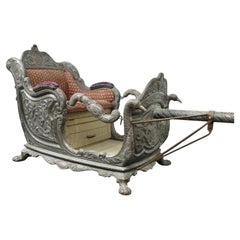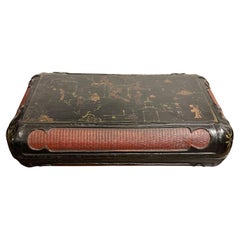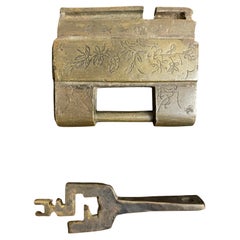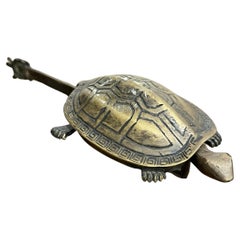Fine Classic Antiques Asian Art and Furniture
to
22
95
17
52
26
17
2
2
1
42
27
26
26
12
95
93
74
17
1
95
95
95
A Pair of Imari Hexagonal Jardinieres, 19th Century
Located in ARMADALE, VIC
A Pair of Imari Hexagonal Jardinieres, 19th Century
Provenance: Private Melbourne Collection.
Description:
The flat lip of each decorated with lotus cartouche panels, the tapering...
Category
Antique 19th Century Japanese Ceramics
Materials
Porcelain
An Indian Silver Foil Overlaid Palaquin, Early 19th Century
Located in ARMADALE, VIC
An Indian Silver Foil Overlaid Palaquin, Early 19th Century
The open scroll and foliate embossed seat with a shaft to each end (one detached).
Provenance: Estate of Gol, Rajasthan,...
Category
Antique Early 19th Century Indian Furniture
Materials
Foil
$79,200 Sale Price
20% Off
One Chinese Black Lacquer Rectangular Lidded Jewelry box, Late 19th Century
Located in ARMADALE, VIC
One Chinese Black Lacquer Rectangular Lidded Jewelry box, Late 19th Century
Provenance: Private Melbourne Collection.
Dimensions: Width: 37cm Height: 10.5cm Depth: 20.5cm.
Category
Antique Late 19th Century Chinese Qing Lacquer
Materials
Wood
A Vintage Chinese Brass Lock with Key
Located in ARMADALE, VIC
A Vintage Chinese Brass Lock with Key
The rectangular lock with incised maple leaves, blossoms and characters; together with a key
Provenance: Pri...
Category
Vintage 1970s Chinese Metalwork
Materials
Brass
$220 Sale Price
50% Off
A Chinese Brass Lock in the Form of a Turtle, Early 20th Century
Located in ARMADALE, VIC
A Chinese Brass Lock in the Form of a Turtle, Early 20th Century
The lock in the form of a turtle with moving legs, the lock mechanism beneath work...
Category
Early 20th Century Chinese Metalwork
Materials
Brass
A Chinese Red Lacquer Baby Bath with Mark, Late 19th Century
Located in ARMADALE, VIC
A Chinese Red Lacquer Baby Bath with Mark, Late 19th Century
Provenance: Private Australian Collection.
Diamension: Height: 14cm Diameter: 42cm.
Category
Antique Late 19th Century Chinese Qing Lacquer
Materials
Wire
$455 Sale Price
30% Off
A Chinese Hand-Carved Red Lacquered Basket with Handle, Late 19th Century
Located in ARMADALE, VIC
A Chinese Hand-Carved Red Lacquered Basket with Handle, Late 19th Century
Provenance: Private Australian Collection.
Dimension: Height: 31cm Width: 27cm Depth: 30cm.
Category
Antique Late 19th Century Chinese Qing Lacquer
Materials
Wood
$572 Sale Price
20% Off
A Chinese Two-Tiered Bamboo and Rattan Lidded Dessert Basket with Handle
Located in ARMADALE, VIC
A Chinese Two-Tiered Bamboo and Rattan Lidded Dessert Basket with Handle, Mid 20th Century
Provenance: Private Australian Collection.
Dimension: Height: 18cm Width: 15.5cm Depth: 1...
Category
Mid-20th Century Chinese Scholar's Objects
Materials
Bamboo, Rattan
$171 Sale Price
55% Off
A Chinese Silver Apple Shaped Lidded Jewellery Box, Early 20th Century
Located in ARMADALE, VIC
A Chinese Silver Apple Shaped Lidded Jewellery Box, Early 20th Century
Provenance: Private Australian Collection Acquired in 1970s.
Dimension: Diameter: 7.5cm Height: 5cm
Category
Early 20th Century Chinese Metalwork
Materials
Silver Plate
$228 Sale Price
40% Off
A Chinese Brass Etched Lock with Key, Early 20th Century
Located in ARMADALE, VIC
A Chinese Brass Etched Lock with Key, Early 20th Century
Provenance: Private Australian Collection.
Dimension: Height: 2.5cm Width: 10cm Depth: 2cm.
Category
Early 20th Century Chinese Qing Metalwork
Materials
Brass
A Chinese Red Lacquer Lidded Box, Early 20th Century
Located in ARMADALE, VIC
A Chinese Red Lacquer Lidded Box, Early 20th Century
Provenance: Private Melbourne Collection.
Dimension: Width: 16cm Height: 9.5cm Depth: 10cm
Category
Early 20th Century Chinese Qing Lacquer
Materials
Wood
$245 Sale Price
30% Off
A Chinese Brass Jewellery Lidded Box, Early 20th Century
Located in ARMADALE, VIC
A Chinese Brass Jewellery Lidded Box, Early 20th Century
Provenance: Private Australian Collection Acquired in 1980s.
Dimension: Width: 11cm Height: 7cm Depth: 9cm.
Category
Early 20th Century Chinese Metalwork
Materials
Brass
A Large Chinese Brass Fish Lock with Key, Early 20th Century
Located in ARMADALE, VIC
A Large Chinese Brass Fish Lock with Key, Early 20th Century
Provenance: Private Perth Collection.
Dimension: Width: 20cm Depth: 10cm Height: 3cm.
Note: The lock is not in working...
Category
Early 20th Century Chinese Qing Metalwork
Materials
Metal, Brass
A Chinese Metal Lock with Key, Late 19th Century
Located in ARMADALE, VIC
A Chinese Metal Lock with Key, Late 19th Century
Provenance: Private Brisbane Collection.
Dimension: Height: 5cm Length: 14cm Depth: 2cm.
Category
Antique Late 19th Century Chinese Qing Metalwork
Materials
Metal
A Chinese Brass Double Fish Shaped Lock with Key, Early 20th Century
Located in ARMADALE, VIC
A Chinese Brass Double Fish Shaped Lock with Key, Early 20th Century
Provenance: Private Australian Collection.
Dimension: Width: 13cm Height: 1cm Depth: 7cm.
Category
Early 20th Century Chinese Qing Metalwork
Materials
Brass
A Chinese Brass Fish Shaped Lock, Early 20th Century
Located in ARMADALE, VIC
A Chinese Brass Fish Shaped Lock, Early 20th Century
Provenance: Private Australian Collection.
Dimension: Length: 10cm Height: 1.5cm Depth: 6cm.
Category
Early 20th Century Chinese Qing Metalwork
Materials
Brass
A Chinese Brass Etched Lock with Key, Early 20th Century
Located in ARMADALE, VIC
A Chinese Brass Etched Lock with Key, Early 20th Century
Provenance: Private Australian Collection Acquired in 1980s
Dimension: Width: 11cm Height: 2.5cm Depth: 1.5cm
Category
Early 20th Century Chinese Qing Metalwork
Materials
Brass
A Chinese Red Lacquer Lidded Jewelry Box, Early 20th Century
Located in ARMADALE, VIC
A Chinese Red Lacquer Lidded Jewelry Box, Early 20th Century
Provenance: Private Australian Collection.
Dimension: Width: 19cm Height: 22.5cm Depth: 21cm.
Category
Early 20th Century Chinese Qing Lacquer
Materials
Wood
$450 Sale Price
50% Off
A Solid Cast Bronze Japanese Figure of Bear, Early 20th Century
Located in ARMADALE, VIC
A Solid Cast Bronze Japanese Figure of Bear, Early 20th Century
Dimension: Height: 15cm Width: 26cm Depth: 11.5cm
Provenance: Private Melbourne Collection.
Category
Early 20th Century Japanese Sculptures and Carvings
Materials
Bronze
$475 Sale Price
50% Off
A Large Chinese Carved Wood Figure of Guanyin, Late Qing Dynasty
Located in ARMADALE, VIC
Description:
A singular example of Guanyin. Deviating from the Bodhisattva’s conventional pose of ‘royal ease’, the figure is instead seated in the meditative padmasana, or ‘lotus position’, rendering this Guanyin something of a rarity. An Apana more typically associated with depictions of Buddhas, Guanyin assuming this pose immediately signifies this figure as one of particular spiritual reverence. Both feet are revealed crossed upon one another from beneath fabric which spills before her, her left palm turned upward with her hand resting upon her left knee and her right raised in a relaxed gesture. Adorned with a diadem housing a depiction of Amitabha Buddha, her own spiritual guide, she exudes an air of tranquil regality, further characterised by her numerous strings of beads and elaborately fastened dhoti, attire traditionally reserved for Indian princes. Though the figure’s dress is Indian her face is undoubtedly exemplifying artistic Chinese beauty standards. Her face is soft and rounded, full in both the lips and cheeks, with eyes that restfully peer down, as though she is watching over the worries of mankind with compassion.
Notes on the item:
Guanyin is the Chinese interpretation of Avalokiteshvara, the Indian Bodhisattva of compassion. The term “Bodhisattva” is derived from the Sanskrit “Bodhi”, meaning ‘awakening’ or ‘enlightenment’, combined with “Sattva”, meaning ‘spirit’ or ‘being’, referring to one on the path to achieving enlightenment. Bodhisattvas in Mayahana Buddhism are recognised as figures who have effectively achieved enlightenment yet relinquish their accension to nirvana in order to remain amongst mankind in the ultimate act of compassion to aid as spiritual guides. As such, the Bodhisattva inhabit a liminal space between samsara and nirvana; enlightened beings that maintain a relationship with humanity that buddhas cannot, as attaining Buddhahood necessitates the abandonment of all worldly attachments, including mankind. Guanyin’s very name, ‘One who hears the cries of the world’ highlights this role as a compassionate figure who acknowledges the suffering and strife of man. Along with Mahāsthāmaprāpta, a fellow bodhisattva, Guanyin serves as an attendant to Buddha Amitabha, with these three deities recognised as the Three Sages of Western Pure Land Buddhism, a sect of Mayahana Buddhism popular in East Asia.
Avalokiteshvara is commonly posited to have been adopted from Indian Buddhism into China as Guanyin around 200-400 CE, however it was the Tang dynasty (618-907) which saw the popularisation of the deity. By the Ming (1358–1644) and Qing (1644–1911) dynasties, Guanyin held the position as the most popular female deity in China. The unique state of religion in China held no monolithic canon regarding Buddhism and saw the assimilation of several belief systems, primarily Daoism, Buddhism and Confucianism. Consequently, Guanyin became a deity to be revered beyond Buddhism alone, appointed as both an official imperial deity and Daoist deity in the 12th century. Guanyin may also be seen to fulfil the role of idealised femininity as prescribed by Confucianism, with the scarcity of female Chinese deities perhaps accounting for the gradual gender shift Guanyin underwent.
The Indian Avalokiteshvara is unequivocally recognised as male, whilst the supposed gender of Guanyin remains contentious. Although there is a clear shift from the masculine Avalokiteshvara towards a more feminine representation, it is unclear if Guanyin is understood to be entirely feminine, to inhabit qualities of both genders or to be elevated beyond gender entirely, embodying neither. Depictions of Guanyin are highly androgynous, which some believe lends credence towards Guanyin symbolising the unity of dualistic forces as recognised in Daoism, displaying the anthropomorphism of yin and yang.
Comparative Analysis:
Market comparisons of similar Qing Dynasty polychrome figures of Guanyin include lot 767 (no.2) From Christies ‘Important Chinese Ceramics and Works of Art,’ New York, 25 March 2022, with the price realised USD 52,920 (Estimate USD 20,000 – USD 30,000). Christies also auctioned a comparable polychrome Guanyin...
Category
Antique Late 19th Century Chinese Qing Sculptures and Carvings
Materials
Hardwood
A Large Chinese Carved Wood Figure of Guanyin, Late Qing Dynasty
Located in ARMADALE, VIC
Description:
A fine depiction of Guanyin, possessing the regal tranquillity that the Chinese Bodhisattva of compassion has come to be visually associated with. Marked by an urna signifying her spiritual enlightenment and crowned with a diadem depicting the Buddha Amitabha, the figure is immediately recognisable as Guanyin. Her androgynous figure is gracefully poised in the Lalit asana or “royal ease”, the pose classical in representations of the deity. The figure is asymmetric, with the weight of her supple form falling upon her left hand placed against the base, her right knee raised and left pendant. Her right hand rests upon her raised knee, delicately pinching at her draped attire. At first unassuming, this gesture may be suggestive of the Apana Mudra, the seal of purification. This Mudra is associated with physical wellbeing, fecundity and the cleansing of the body. Though she is adorned in the princely garb of dhoti, she bears features of idealised feminine beauty as prescribed in Asian art. With plump cheeks and near pouted lips, her full face gazes down upon the viewer with an empathetic and half-lidded gaze, upholding her title as ‘One who hears the cries of the world.’
Notes on the item:
Guanyin is the Chinese interpretation of Avalokiteshvara, the Indian Bodhisattva of compassion. The term “Bodhisattva” is derived from the Sanskrit “Bodhi”, meaning ‘awakening’ or ‘enlightenment’, combined with “Sattva”, meaning ‘spirit’ or ‘being’, referring to one on the path to achieving enlightenment. Bodhisattvas in Mayahana Buddhism are recognised as figures who have effectively achieved enlightenment yet relinquish their accension to nirvana in order to remain amongst mankind in the ultimate act of compassion to aid as spiritual guides. As such, the Bodhisattva inhabit a liminal space between samsara and nirvana; enlightened beings that maintain a relationship with humanity that buddhas cannot, as attaining Buddhahood necessitates the abandonment of all worldly attachments, including mankind. Guanyin’s very name, ‘One who hears the cries of the world’ highlights this role as a compassionate figure who acknowledges the suffering and strife of man. Along with Mahāsthāmaprāpta, a fellow bodhisattva, Guanyin serves as an attendant to Buddha Amitabha, with these three deities recognised as the Three Sages of Western Pure Land Buddhism, a sect of Mayahana Buddhism popular in East Asia.
Avalokiteshvara is commonly posited to have been adopted from Indian Buddhism into China as Guanyin around 200-400 CE, however it was the Tang dynasty (618-907) which saw the popularisation of the deity. By the Ming (1358–1644) and Qing (1644–1911) dynasties, Guanyin held the position as the most popular female deity in China. The unique state of religion in China held no monolithic canon regarding Buddhism and saw the assimilation of several belief systems, primarily Daoism, Buddhism and Confucianism. Consequently, Guanyin became a deity to be revered beyond Buddhism alone, appointed as both an official imperial deity and Daoist deity in the 12th century. Guanyin may also be seen to fulfil the role of idealised femininity as prescribed by Confucianism, with the scarcity of female Chinese deities perhaps accounting for the gradual gender shift Guanyin underwent.
The Indian Avalokiteshvara is unequivocally recognised as male, whilst the supposed gender of Guanyin remains contentious. Although there is a clear shift from the masculine Avalokiteshvara towards a more feminine representation, it is unclear if Guanyin is understood to be entirely feminine, to inhabit qualities of both genders or to be elevated beyond gender entirely, embodying neither. Depictions of Guanyin are highly androgynous, which some believe lends credence towards Guanyin symbolising the unity of dualistic forces as recognised in Daoism, displaying the anthropomorphism of yin and yang.
Comparative Analysis:
Market comparisons of similar Qing Dynasty polychrome figures of Guanyin include lot 767 (no.2) From Christies ‘Important Chinese Ceramics and Works of Art,’ New York, 25 March 2022, with the price realised USD 52,920 (Estimate USD 20,000 – USD 30,000). Christies also auctioned a comparable polychrome Guanyin...
Category
Antique Late 19th Century Chinese Qing Sculptures and Carvings
Materials
Hardwood
A Large Chinese Carved Wood Figure of Guanyin, Late Qing Dynasty
Located in ARMADALE, VIC
An impressive depiction of Guanyin, the Bodhisattva of compassion, whose name bears the meaning ‘One who hears the cries of the world.’ The rather androgynous figure is adorned with beaded jewellery and the princely regalia of a dhoti, draped across her body and spilling out over to partially obscure what she is resting upon. The goddess’ profile exhibits idealised features of Asian artistic convention; her face is soft and rounded, with full lips and relaxed eyes that provide a serene quality of youthfulness to the figure. Adhering to Chinese iconography of Guanyin, the figure is marked by an urna on her forehead, denoting her own enlightenment, as well as a diadem displaying Buddha Amitabha, the spiritual teacher of Guanyin. Seated in the Lalit asana pose, translated as ‘royal ease’, the figure exudes a fine example of the relaxed majesty typical in the characterisation of Guanyin. Whilst the figure’s left hand is placed restfully upon the left leg pendant, the right is raised in the gesture shuni mudra, the second finger held gently against the thumb. Otherwise known as the seal of patience, this gesture indicates the figure as one intended to bestow this virtue, along with compassion and understanding, upon the beholder.
Notes on the item:
Guanyin is the Chinese interpretation of Avalokiteshvara, the Indian Bodhisattva of compassion. The term “Bodhisattva” is derived from the Sanskrit “Bodhi”, meaning ‘awakening’ or ‘enlightenment’, combined with “Sattva”, meaning ‘spirit’ or ‘being’, referring to one on the path to achieving enlightenment. Bodhisattvas in Mayahana Buddhism are recognised as figures who have effectively achieved enlightenment yet relinquish their accension to nirvana in order to remain amongst mankind in the ultimate act of compassion to aid as spiritual guides. As such, the Bodhisattva inhabit a liminal space between samsara and nirvana; enlightened beings that maintain a relationship with humanity that buddhas cannot, as attaining Buddhahood necessitates the abandonment of all worldly attachments, including mankind. Guanyin’s very name, ‘One who hears the cries of the world’ highlights this role as a compassionate figure who acknowledges the suffering and strife of man. Along with Mahāsthāmaprāpta, a fellow bodhisattva, Guanyin serves as an attendant to Buddha Amitabha, with these three deities recognised as the Three Sages of Western Pure Land Buddhism, a sect of Mayahana Buddhism popular in East Asia.
Avalokiteshvara is commonly posited to have been adopted from Indian Buddhism into China as Guanyin around 200-400 CE, however it was the Tang dynasty (618-907) which saw the popularisation of the deity. By the Ming (1358–1644) and Qing (1644–1911) dynasties, Guanyin held the position as the most popular female deity in China. The unique state of religion in China held no monolithic canon regarding Buddhism and saw the assimilation of several belief systems, primarily Daoism, Buddhism and Confucianism. Consequently, Guanyin became a deity to be revered beyond Buddhism alone, appointed as both an official imperial deity and Daoist deity in the 12th century. Guanyin may also be seen to fulfil the role of idealised femininity as prescribed by Confucianism, with the scarcity of female Chinese deities perhaps accounting for the gradual gender shift Guanyin underwent.
The Indian Avalokiteshvara is unequivocally recognised as male, whilst the supposed gender of Guanyin remains contentious. Although there is a clear shift from the masculine Avalokiteshvara towards a more feminine representation, it is unclear if Guanyin is understood to be entirely feminine, to inhabit qualities of both genders or to be elevated beyond gender entirely, embodying neither. Depictions of Guanyin are highly androgynous, which some believe lends credence towards Guanyin symbolising the unity of dualistic forces as recognised in Daoism, displaying the anthropomorphism of yin and yang.
Comparative Analysis:
Market comparisons of similar Qing Dynasty polychrome figures of Guanyin include lot 767 (no.2) From Christies ‘Important Chinese Ceramics and Works of Art,’ New York, 25 March 2022, with the price realised USD 52,920 (Estimate USD 20,000 – USD 30,000). Christies also auctioned a comparable polychrome Guanyin...
Category
Antique Late 19th Century Chinese Qing Sculptures and Carvings
Materials
Hardwood
A Chinese Glass Snuff Bottle, 20th Century
Located in ARMADALE, VIC
A Chinese Glass Snuff Bottle, 20th Century
Dimension: Height: 9 cm Diameter: 9 cm.
Provenance: Private Western Australian Collection.
Category
20th Century Chinese Scholar's Objects
Materials
Glass
A Tibetan Prayer Book In Wooden Casing, 19th Century
Located in ARMADALE, VIC
A Tibetan Prayer Book in Wooden Casing, 19th Century
Aged leaves bound with leather strapping between hard covers.
Length: 53.5 cm Width: 13.5 cm...
Category
Antique 19th Century Tibetan Paintings and Screens
Materials
Hardwood, Paper
A Chinese Famille Verte Baluster Jar, 19th century
Located in ARMADALE, VIC
A Famille Verte Baluster Jar, 19th Century
Decorated with shaped panels of landscapes and mythical beasts reserved on a floral decorated black ground.
Height: 45 cm Diameter: 37 cm...
Category
Antique 19th Century Chinese Qing Ceramics
Materials
Porcelain
A Pair of Chinese Gilded and Lacquered Cabinets, Qing Dynasty
Located in ARMADALE, VIC
A Pair of Chinese Gilded and Lacquered Cabinets, Qing Dynasty
Rectangular, decorated with bat and cloud motif to body, with gilded and relief car...
Category
Antique 19th Century Chinese Qing Furniture
Materials
Hardwood
A QINGBAI BOWL Song Dynasty Ex Sotheby's
Located in ARMADALE, VIC
A Chinese QINGBAI BOWL, Song Dynasty
Height: 6.5 cm Diameter: 17.5 cm
Provenance: Sotheby's, London, Oriental Ceramics and Works of Art, Lot 77, 06/02/1979
Category
Antique 15th Century and Earlier Chinese Ceramics
Materials
Ceramic
One Blue and White Dish, Yongzheng Period, Qing Dynasty Ex Sotheby's
Located in ARMADALE, VIC
One Blue and White Dish, Yongzheng Period, Qing Dynasty
Painted figures on bridge in landscape
Diameter: 11.5cm Height: 2cm
Provenance: Made in Imperial China Porcelain from the C...
Category
Antique Early 18th Century Chinese Qing Ceramics
Materials
Ceramic, Porcelain
One Blue and White Dish, Yongzheng Period, Qing Dynasty Ex Sotheby's
Located in ARMADALE, VIC
One Blue and White Dish, Yongzheng Period, Qing Dynasty
Painted figures on bridge in landscape
Diameter: 11.5cm Height: 2cm
Provenance: Made in Imperial China Porcelain from the C...
Category
Antique Early 18th Century Chinese Qing Ceramics
Materials
Ceramic, Porcelain
A Pair of Chinese Cloisonne Baluster Vases, Late 19th Century
Located in ARMADALE, VIC
A Pair of Chinese Cloisonne Baluster Vases, Late 19th Century
Each of baluster form with an everted lip and trumpet neck descending to broad shoulders and a flared base, the enamelw...
Category
Antique Late 19th Century Chinese Qing Metalwork
Materials
Bronze
A Chinese Longquan Celadon Lotus Bowl, Ming Dynasty
Located in ARMADALE, VIC
A Chinese Longquan Celadon Lotus Bowl, Ming Dynasty
Diameter: 16.7 cm Height: 5.5 cm
Provenance: The Collection of Dr. John Yu AC
Dr. Yu was the Foundi...
Category
Antique 15th Century and Earlier Chinese Ming Ceramics
Materials
Ceramic
$1,575 Sale Price
30% Off
An Impressive Large Chinese Black Lacquered Wood Temple, Late 19th Century
Located in ARMADALE, VIC
An Impressive Large Chinese Black Lacquered Wood Temple, Late 19th Century
with open work florette diaper doors to the front
Provenance: Pri...
Category
Antique Late 19th Century Chinese Furniture
Materials
Hardwood
A Chinese Deep Brown Glazed Footed Bowl, 15th Century
Located in ARMADALE, VIC
A Chinese Deep Brown Glazed Footed Bowl, 15th Century
Provenance: The Collection of Dr. John Yu AC
Dimension: Height: 7.3 cm. Dimension: 15.5 cm
Dr. Yu was the Founding Chair of V...
Category
Antique 15th Century and Earlier Chinese Ming Ceramics
Materials
Terracotta
$735 Sale Price
30% Off
An Impressive Large Celadon Charger, 20th Century
Located in ARMADALE, VIC
An Impressive Large Celadon Charger, 20th Century
Provenance: Private Melbourne Collection
Dimension: Height: 8.5 cm Diameter: 76 cm
Category
Mid-20th Century Chinese Ming Ceramics
Materials
Celadon
$1,560 Sale Price
35% Off
A Chinese Hardwood Miniature Table Form Stand, Late 19th century
Located in ARMADALE, VIC
A Chinese Hardwood Miniature Table Form Stand, Late 19th century
Dimension: Height: 11.5 cm Length: 32 cm. Depth: 12 cm.
Provenance: Old Melbourne Chinese Collection.
Category
Antique Late 19th Century Chinese Scholar's Objects
Materials
Hardwood
